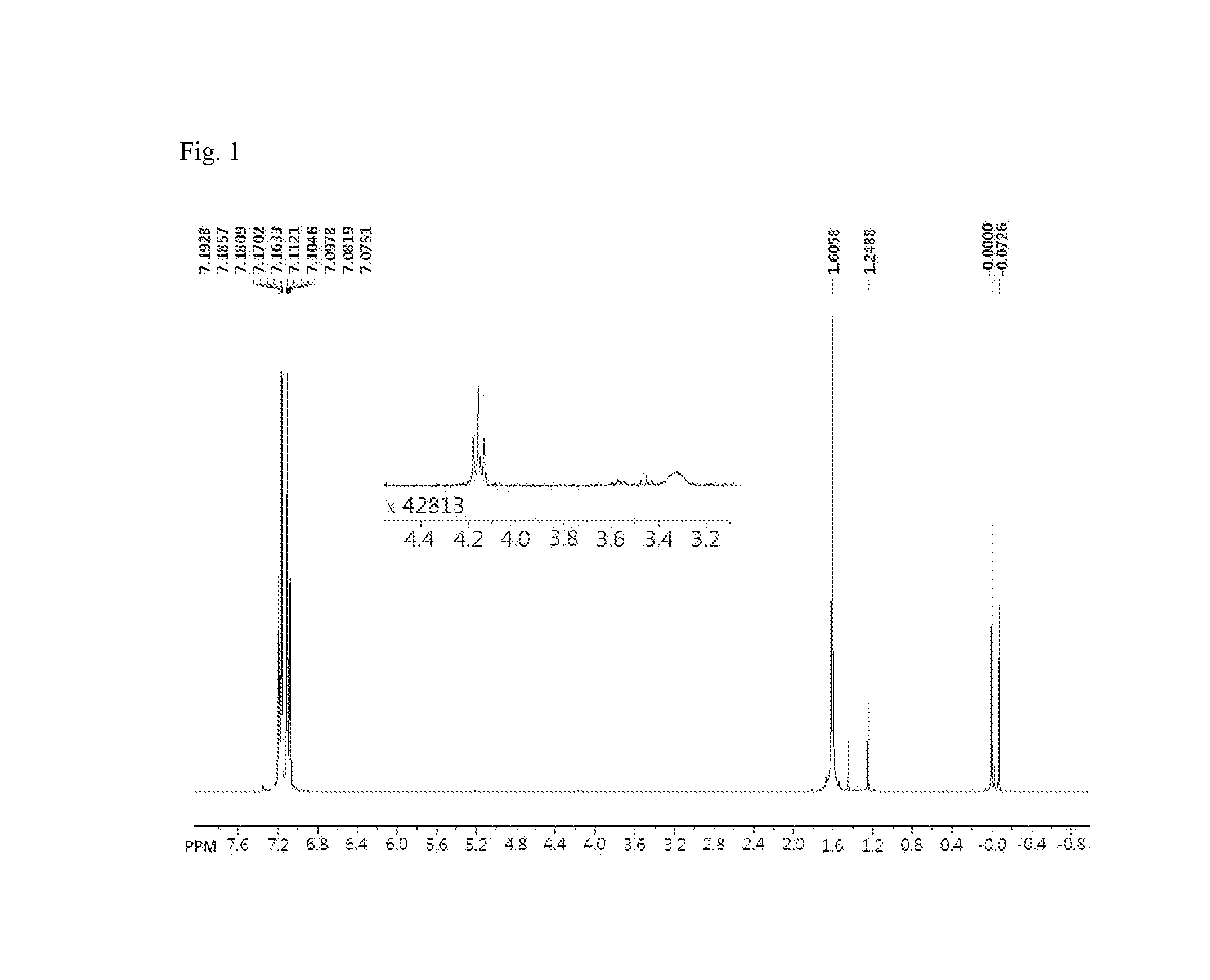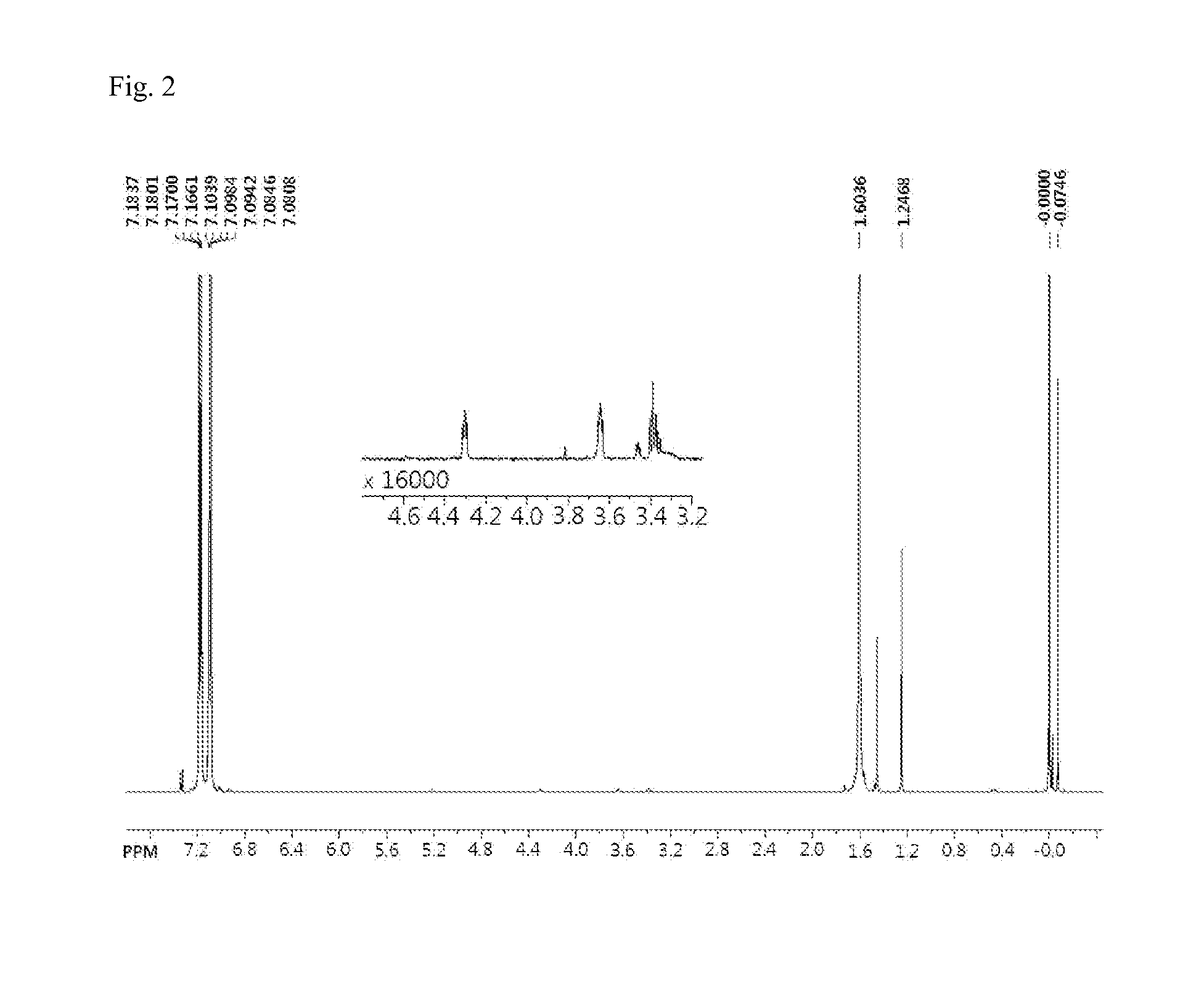Polycarbonate-Polysiloxane Copolymer, and Method for Preparing Same
a polycarbonate and polysiloxane technology, applied in the field of polycarbonatepolysiloxane copolymer and a method for preparing the same, can solve the problems of deterioration of intrinsic transparency of polycarbonates, difficult to realize the expression of various colors recently required for resins, and difficult to achieve the effect of various colors, high reaction participation rate, and excellent physical properties
- Summary
- Abstract
- Description
- Claims
- Application Information
AI Technical Summary
Benefits of technology
Problems solved by technology
Method used
Image
Examples
example
Example 1
[0047]To a 20 L glass reactor, 50 wt % NaOH was mixed with 7 L of distilled water by stirring. To the obtained mixture, 1.50 kg of bisphenol-A was added. After the temperature of the solution became 22° C. or less, 3 L of methylene chloride, 41.5 g of t-butyl phenol, and 118 g of a siloxane compound represented by Formula 2-1 were added and vigorously stirred. To this stirred solution, a solution prepared by dissolving 974 g of triphosgene in 3 L of methylene chloride was added at a rate of 60 mL / minute. It was observed that there was an increase in reaction temperature. When the reaction temperature decreased to 23° C. or less after 1 hour, 7.80 g of triethylamine was added to the solution, and the temperature of the reactor was kept at 30° C. or more. After stirring the solution for 2 hours, the separated organic layer was washed with a mixed solution of 6 L of water and 10 mL of 50 wt % NaOH once, a mixed aqueous solution of 6 L of water and 60 mL of 35% HCl once, and 12...
example 2
[0048]The same procedure as in Example 1 was performed except that a siloxane compound represented by Formula 2-2 was used instead of the siloxane compound represented by Formula 2-1. Finally, 1.5 kg of a polycarbonate-polysiloxane copolymer was obtained. DOSY and 1H NMR analysis of the polymer showed that a siloxane polymer bonded to a backbone of the polycarbonate was present. 1H NMR analysis showed that the Si content was 2.12 wt % and GPC analysis showed that Mw was 22,300 g / mol. An integrated value of 3.45 ppm of an unreacted PDMS monomer and 4.18 ppm of a copolymerized PDMS monomer on 1H NMR spectrum showed that 95% of terminal hydroxyl groups participated in the copolymer.
example 3
[0049]The same procedure as in Example 1 was performed except that a siloxane compound represented by Formula 2-3 was used instead of the siloxane compound represented by Formula 2-1. Finally, 1.5 kg of a polycarbonate-polysiloxane copolymer was obtained. DOSY and 1H NMR analysis of the polymer showed that a siloxane polymer bonded to a backbone of the polycarbonate was present, and 1H NMR analysis showed that the Si content was 2.10 wt %. GPC analysis showed that Mw was 20,600 g / mol. An integrated value of 3.60 ppm of an unreacted PDMS monomer and 4.20 ppm of a copolymerized PDMS monomer on 1H NMR spectrum showed that 88% of terminal hydroxyl groups participated in the copolymer.
PUM
| Property | Measurement | Unit |
|---|---|---|
| haze | aaaaa | aaaaa |
| haze | aaaaa | aaaaa |
| haze | aaaaa | aaaaa |
Abstract
Description
Claims
Application Information
 Login to View More
Login to View More - R&D
- Intellectual Property
- Life Sciences
- Materials
- Tech Scout
- Unparalleled Data Quality
- Higher Quality Content
- 60% Fewer Hallucinations
Browse by: Latest US Patents, China's latest patents, Technical Efficacy Thesaurus, Application Domain, Technology Topic, Popular Technical Reports.
© 2025 PatSnap. All rights reserved.Legal|Privacy policy|Modern Slavery Act Transparency Statement|Sitemap|About US| Contact US: help@patsnap.com



